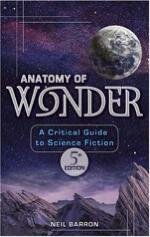

Anatomy of Wonder: A Critical Guide to Science Fiction, 5th Edition, edited by Neil Barron
Reviewed by Steve Jeffrey
Libraries Unlimited, Westport CT, 2004, 995pp, $80.00/$45.99, h/b, ISBN 1-59158171-0
This is the fifth, and judging by Barron's valedictory Preface, possibly the final edition of Anatomy of Wonder. It has been substantially updated, revised and enlarged from its 1995 predecessor and now weighs in at over twice the length of its original incarnation in 1976. The first and third editions of this Guide were previously reviewed in Vector by Brian Stableford (Nov 1976), and Paul Kincaid (April 1988) who are both contributors to this volume, alongside an impressive list of critics, reviewers, academics and commentators.
Anatomy of Wonder, its editor tells us, is intended for a broad and overlapping readership, ranging from academics and teachers, scholars and librarians, to the sf reader, fan and the 'casually curious' (non-genre) reader, although I suspect that the price of this edition may put it beyond the reach of all but the most devoted of the latter.
The work is divided into three main sections (it is rounded off by over 100 pages of indexes, by author, title and theme, of which more later). Part I, 'The Primary LiteratureA Critical History', is an overview of the history and development of the genre, divided chronologically into five chapters. Brian Stableford opens with 'The Emergence of Science Fiction, 15161914' (Stableford starts, for argument's sake, with More's Utopia) and 'Science Fiction Between the Wars, 19151939'. On the very first page, though, we encounter one of those niggling problems that are bound to beset critical guides intended for a wide-ranging readership: that of definition. Stableford largely sidesteps the issue, referring the interested reader to Wolfe's Critical Terms for Science Fiction and Fantasy: A Glossary and Guide (1986), which may be the better part of valour but is not entirely helpful in a volume indended, in part, as a teaching guide. The issue of definitions is tackled later on, in Part III, but since there is no subject index, you have to read the whole work to realise this, which rather negates the point of a reference work. The lack of a proper subject index is, however, possibly the only criticism I have of Anatomy of Wonder for how it works on its own terms.
Paul A. Carter takes up the story in Chapter 3, 'From the Golden Age to the Atomic Age: 19401963' while Michael M. Levy brings us up to date with 'The New Wave and After, 19641984' and 'Cyberpunk and Beyond, 19842004'. On the whole, the coverage is well balanced between developments on both sides of the Atlantic, and includes nods towards the British Boom in a short section 'Space Opera Redux', the increasing genre-mainstream crossover, and the advent of the New Weird. At barely 85 pages, the critical history presented cannot hope to be as detailed or comprehensive as more specialised works, such as Stableford's Scientific Romance in Britain (1985) or Edward James's Science Fiction in the Twentieth Century (1994), but serves as a useful adjunct to these and others.
Part II, 'Primary LiteratureAnnotated Bibliography', takes up the largest chunk of the book, with some 1400 titles, alphabetically arranged by author and also indexed by theme and references to similar works. In this it follows the model of M.H. Zool's Good Reading Guide to Science Fiction and Fantasy (1989) and David Pringle's The Ultimate Guide to Science Fiction (1990), although the latter is arranged alphabetically by title. This is also the part, one suspects, that gave the publishers most grief, as the temptation is to add ever more up-to-date titles. The latest reference I can find is a note on Stephen Baxter's Exultant (2004).
Part III, 'Secondary LiteratureAnnotated Bibliography', serves a similar purpose for critical and reference works on or about science fiction, but is necessarily more of a catch-all, including publishing and magazine statistics, online resources (expanded from the previous edition), library collections, media (including radio), illustration and awards. The division between general reference (37 titles) and history and criticism (251 titles) seems somewhat arbitrary, but as a whole the list feels comprehensive. Along with annotated references to a further 173 author studies, it included all of the titles (3 dozen or so) on my own shelves, apart from those specific to fantasy, including the Zool Reading Guide mentioned above, Andrew M. Butler's Pocket Essential Cyberpunk (2000), and (pleasingly) fan studies such as Harry Warner's All Our Yesterdays (1970).
The selection of 'Best Books' chosen by the contributors, in Chapter 16, 'Listings' (along with a miscellany of Awards, Series and Young Adult Books and Translations) is the one most likely to provoke disagreement and debate, but then, fans being what they are, that is an almost inevitable result of any published list.
If it wasn't for the price, I'd have little hesitation in recommending this to anyone with a serious interest in sf criticism, but if your budget doesn't stretch that far, badger your central library to add this to their collection.
This article first appeared in Vector 245. Back issues of Vector are available from
